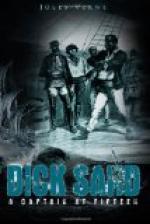The fact is that little Jack had a right to claim some of these charming creatures, for he was now in a country where they should abound. The Indians, who know how to weave their feathers artistically, have lavished the most poetical names on those jewels of the flying race. They call them either the “rays” or the “hairs of the sun.” Here, it is “the little king of the flowers;” there, “the celestial flower that comes in its flight to caress the terrestrial flower.” It is again “the bouquet of jewels, which sparkles in the fire of the day.” It can be believed that their imagination would know how to furnish a new poetical appellation for each of the one hundred and fifty species which constitute this marvelous tribe of humming-birds.
Meanwhile, however numerous these humming-birds might be in the forests of Bolivia, little Jack was obliged to still content himself with Harris’s promise. According to the American, they were still too close to the coast, and the humming-birds did not like these deserts so near the ocean. The presence of man did not frighten them at the “hacienda;” they heard nothing all day but their cry of “teretere” and the murmur of their wings, similar to that of a spinning-wheel.
“Ah! how I should like to be there!” cried little Jack.
The surest method of getting there—to the “hacienda” of San Felice—was not to stop on the road. Mrs. Weldon and her companions only took the time absolutely necessary for repose.
The aspect of the forest already changed. Between the less crowded trees large clearings opened here and there. The sun, piercing the green carpet, then showed its structure of red, syenite granite, similar to slabs of lapis-lazuli. On some heights the sarsaparilla abounded, a plant with fleshy tubercles, which formed an inextricable tangle. The forest, with the narrow paths, was better for them.
Before sunset the little troop were about eight miles from the point of departure. This journey had been made without accident, and even without great fatigue. It is true, it was the first journey on the march, and no doubt the following halting places would be rougher.
By a common consent they decided to make a halt at this place. The question then was, not to establish a real camp, but to simply organize a resting-place. One man on guard, relieved every two hours, would suffice to watch during the night, neither the natives nor the deer being truly formidable.
They found nothing better for shelter than an enormous mango-tree, whose large branches, very bushy, formed a kind of natural veranda. If necessary, they could nestle in the branches.
Only, on the arrival of the little troop, a deafening concert arose from the top of the tree.
The mango served as a perch for a colony of gray parrots, prattling, quarrelsome, ferocious birds, which set upon living birds, and those who would judge them from their congeners which Europe keeps in cages, would be singularly mistaken.




